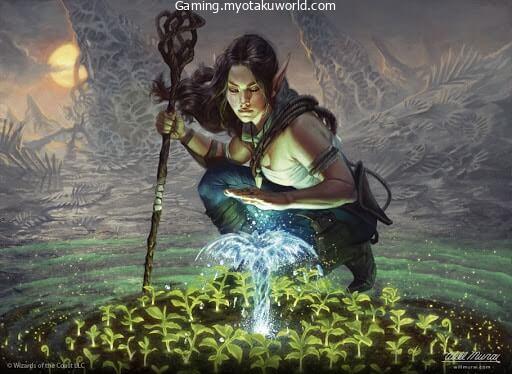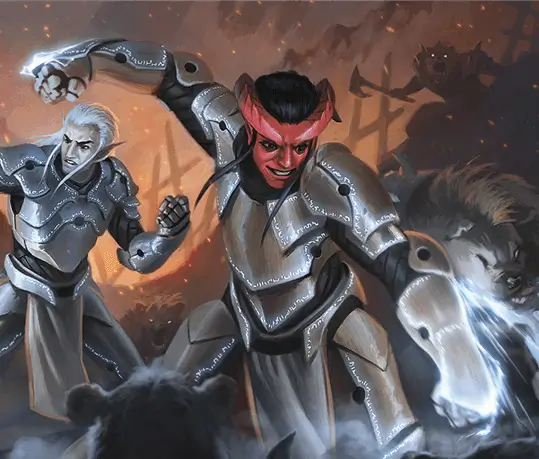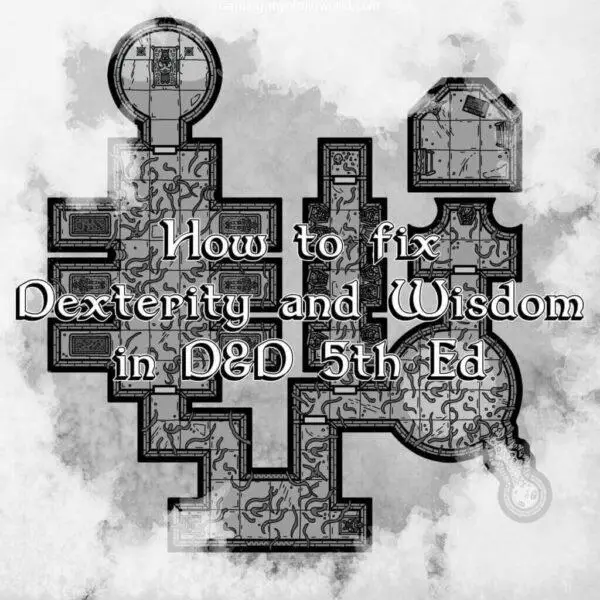In Dungeons & Dragons 5th Edition, Charmed Condition is a fairly common tactic to try to change the way another creature thinks, both in battle and in social situations.
One way is to make your character (or monster) an ally of the person or thing you want to help by giving them the Charmed condition.
But what is this “Charmed” thing? How does it work? And what powers does it have?
This guide for new players explains everything you need to know about the Charmed condition in D&D 5e.
Let’s start by looking at what the 5e condition “Charmed” says in plain English.
- What is Charmed Condition in 5e?
- How Does Charmed Work in 5e?
- How Will Charmed Affect Combat?
- How Charmed Affects Social Encounters?
- Charm Spells in 5e
- How To Stop the Charmed Condition?
- Resisting Through Saving Throws
- Spells That Counteract Charm
- Taking Damage
- Class Features
- Charmed vs Frightened
- How To Defend Against Charm Person?
- FAQs
What is Charmed Condition in 5e?
In 5e, the “Charmed” condition is mostly a way to give a creature an advantage (though not necessarily a real advantage) in a social situation or to distract an enemy creature during battle.
Because of this condition, the charming creature sees the charmer as a good or even friendly person.
The charming condition changes how a creature sees another creature. This change puts the charmer in a better position with the creature that was affected, usually as a friend.
On page 290 of the Player’s Handbook, Appendix A gives a list of what the Charmed condition does:
A charmed creature can’t attack the charmer or target the charmer with harmful abilities or magical effects.
The charmer has advantage on any ability check to interact socially with the creature.
Keeping these effects in mind, let’s look at how the Charmed condition works and how it affects gameplay.
How Does Charmed Work in 5e?

The condition of being “Charmed” is caused by magic. It changes how an affected creature sees the charmer, making the charmer seem like someone they know or like.
Almost every effect that makes a person “Charmed” is a magical one. That doesn’t mean that these effects are always spells.
For example, many monsters have abilities that make other creatures like them.
At its most basic level, a creature that has been charmed sees the charmer as a friend or ally.
Also, the effects that cause this condition don’t usually last very long.
Most of the time, they only last for up to 1 minute.
Some abilities last longer than others, so be sure to read the description carefully.
So, the question is, what happens when you’re charmed?
Well, when you’re Charmed in 5e, two things happen. First, a creature that has been charmed can’t attack or hurt the person who has charmed it.
Second, it’s easier for the charmer to talk to a creature that has been “Charmed.”
Let’s look at how each of these things works.
How Will Charmed Affect Combat?
The first effect says that a creature that has been charmed “cannot attack the charmer or use harmful abilities or spells to target the charmer.”
So, a creature that has been charmed can no longer attack the charmer or use abilities or effects that do damage to the charmer.
Effects that hurt a target without using an attack roll count for the second part.
For example, the phantasmal killer spell forces a creature to make a saving throw or become frightened and take psychic damage.
It’s not always clear what “…harmful abilities or magical effects” mean. I would say that it is anything that would hurt a creature.
Most of the time, this means hurting the target, but putting them in another condition should probably also count.
This use has the most effect on fights.
Assuming that the ability that gives the “Charmed” condition doesn’t do anything else, using a spell or ability to give a hostile creature this condition takes its mind off of something else.
This could be an excellent way to keep a monster from going after the healer or caster in the group.
How Charmed Affects Social Encounters?
The second effect of being charmed in 5e is that it gives the charmer an advantage on all ability checks to “get along with the creature.”
This usually means that any Charisma (Deception), Charisma (Intimidation), Charisma (Persuasion), or Charisma (Intimidation) checks have an advantage while the charm is active.
But if a player thinks outside the box, it could affect other checks.
In essence, this effect of being charmed makes it easier for the charmer to meet new people.
On the other hand, charm effects don’t often help other creatures in this way.
So, if your whole party interacts with a non-player character who hates them as a group, that NPC may still be hesitant to talk to one of them even after being Charmed.
Also, most charm spells say that once the effect wears off, the creature becomes hostile.
If a player doesn’t get what they want while the charming effect is in effect, they’ll have to deal with an angry person.
Charm Spells in 5e
There are a few spells in D&D 5e that give creatures the “Charmed” condition. Most of the time, these spells come from the Enchantment school of magic.
They usually affect a certain kind of creature, and most of the time, the creature becomes hostile to the charmer.
There are a few spells that player characters and creatures that can cast spells can use to give another creature the “Charmed” condition.
The levels of these spells range from 1st to 8th, so Game Masters and players can use them at almost any level of play.
Here is a list of all the 5e Charm spells:
- Animal Friendship – 1st-level (Beast creature type only)
- Charm Person – 1st-level (Humanoid creature type only)
- Crown of Madness – 2nd-level (Humanoid creature type only)
- Nathair’s Mischief – 2nd-level
- Fast Friends – 3rd-level (Humanoid creature type only)
- Hypnotic Pattern – 3rd-level
- Incite Greed – 3rd-level
- Charm Monster – 4th-level
- Dominate Beast – 4th-level (Beast creature type only)
- Awaken – 5th-level (Beast or Plant creature types only)
- Dominate Person – 5th-level (Humanoid creature type only)
- Geas – 5th-level
- Modify Memory – 5th-level
- Dominate Monster – 8th-level
Now, some of these spells change the way being “Charmed” works in a small way.
Even though the base effects still happen, they might have a catch or do something extra.
For example, the modified memory spell charms the creature it’s meant for but makes it unable to move while the caster changes its memory.
How To Stop the Charmed Condition?
Most creatures have a few ways to stop being charmed, so it’s not hard to get rid of the effect.
You could do one of these things: pass a saving throw, use a spell to cancel out the effect, or take damage from the charmer or their allies.
Like most other conditions, Charm effects in D&D 5e usually have a way to stop them or end them early.
Most of the ways to stop a Charmed effect are the same as for other conditions, but there is one unique way.
In 5e, there are three main ways to stop being “Charmed”:
- Saving Throws
- Spells
- Damage
Let’s go through each one, starting with the one that requires the least work: just make your saves.
Resisting Through Saving Throws
Many abilities that give creatures the “Charmed” condition let them try to get rid of it on their next turn.
Most of the time, you have to make a saving throw to avoid the effects of abilities that give you the “Charmed” condition.
Most of the time, these abilities require a Wisdom saving throw because resisting the enchantment is a test of will.
Lucky for us, most effects that give creatures the “Charmed” condition let them try to break it on their next turn by making saves.
Also, monsters’ natural abilities often have a caveat that if they save once against a Charm effect, they are immune to that effect for the rest of their lives.
This immunity sometimes covers effects from the same kind of creature, but it usually only affects the first monster.
For example, the Harpy’s Luring Song action says, “A target that successfully saves is immune to this harpy’s song for the next 24 hours.”
So, a creature may pass a save against one harpy, but a different harpy’s Luring Song could still give it the Charmed condition.
All you have to do is read carefully about how monsters and spells work.
Even though it’s not very impressive and has a higher chance of failing due to different Wisdom save bonuses, saving throws are the easiest for both player characters and monsters to use because they can all roll saves against the Charm effect.
Still, some spells make it easy to get rid of the charmed condition.
Spells That Counteract Charm
Some 5e spells can help get rid of the charming condition faster.
Using spells to get rid of the “Charmed” condition is a bit harder than it sounds. This might be because most charm effects don’t last very long.
Most of the time, it doesn’t seem worth it to spend a spell slot to end a 1-minute effect. Even more so when the creature affected has a chance to save itself.
Still, 5e does have a few spells you can use to get rid of the Charmed condition if you want to.
- Calm Emotions – 1st-level (Humanoid creature type only, also suppresses the Charmed condition for the duration)
- Dispel Evil and Good – 5th-level (only works on effects from Celestial, Elemental, Fey, Fiend, or Undead creatures)
- Greater Restoration – 5th-level
- Power Word: Heal – 9th-level
Aside from spells and saves, the only other way to get rid of the Charmed condition is to take some damage.
Taking Damage
Taking damage from the charmer or one of their allies often ends the effect of a spell or ability that causes the Charmed condition.
Many spells that give the charming condition have a catch: if the charmer does damage to the creature, the charmed condition goes away.
Also, these spells include the charmer’s allies and often have a warning like the one in the charm person spell:”[the creature] is charmed by you until the spell ends or until you or your allies do something harmful to it.”
Even though these caveats don’t say the same thing in words, they mean pretty much the same thing: if the charmer or their allies hurt the creature with the effect, the effect ends.
Now, this isn’t something that most monster abilities say.
If a monster’s ability gives the Charmed condition to a creature, dealing damage to that creature usually doesn’t do anything.
The best ways to get these effects are to save it or use a spell, which is more reliable.
So, even if a monster’s effect has a catch for hurting a charming creature, it usually just gives the creature another chance to make a saving throw against the effect.
For example, the Succubus’s Charm ability says that if a creature “suffers any harm,” it can try to save it again, and if it succeeds, the effect ends.
Aside from that, if you fail the save against the charm ability, you will be charmed for 24 hours.
The Luring Song skill of the Harpy is another example.
It says that you might get hurt if you go through dangerous terrains, like lava or a deep enough pit.
Also, the ability says that the target can try again on the saving throw “whenever it takes damage from a source other than the harpy.”
So, if a creature is Charmed because of a Harpy’s Luring Song, it can make a saving throw to end the effect early if it is about to enter dangerous terrain or if it takes damage from a creature other than the Harpy.
So, damage can be a good, almost desperate way to try to end the Charmed status, as long as the effect that gave you this status lets you.
Class Features
Some of the features of the D&D 5e classes work against the Charmed condition.
The biggest problem with the class features that end the Charmed condition is that none of them can be used until level 6. Even so, you could say the same thing about spells.
Also, only a few of these traits help other creatures. Most of these traits only allow the character.
So, you won’t be able to do much to counter the Charmed condition with your party.
Still, a few of these things, like the Aura of Devotion of the Devotion Paladin, do help creatures other than the character.
- Barbarian (Path of the Berserker): Mindless Rage – 6th-level
- Bard: Countercharm – 6th-level (advantage against Charm)
- Druid (Circle of the Land): Nature’s Ward – 10th-level (only against Fey and Elemental creatures)
- Paladin (Oath of Devotion): Aura of Devotion – 7th-level
- Warlock (The Archfey): Beguiling Defenses—10th-level
- Fighter (Psi Warrior Martial Archetype): Guarded Mind – 10th-level
- Ranger (Fey Wanderer Ranger Archetype): Beguiling Twist – 7th-level (advantage against Charm)
- Sorcerer (Aberrant Mind Sorcerous Origin): Psychic Defenses – 6th-level (advantage against Charm)
Some other class abilities indirectly stop charm effects or work against them.
But because they don’t mention the charmed condition, I left them off the list.
Charmed vs Frightened
Both the “Charmed” and “Frightened” conditions change the way a creature sees things.
But, from a mechanical point of view, they do very different things.
Both the “Charmed” and “Frightened” conditions affect a creature by changing how it sees things. On the one hand, a charming creature sees the charmer as friendly or at least reliable.
On the other hand, the frightened condition makes a person afraid of a creature so much that they can’t even approach it on their own.
These things also have different effects on combat but in different ways.
When a creature has the charmed condition, it can’t hurt the charmer directly or indirectly.
In a fight, this means that a creature that has been afflicted can’t help attacking the charmer, dividing the attention of the party or group of monsters when it would be better to focus on one high-threat individual.
On the other hand, when a creature is frightened, it can’t move toward the thing that’s making it scared. This makes the creature less mobile.
Also, the affected creature has a disadvantage on all attacks and skill checks while it can see the source of its fear.
This makes combat even harder.
So, both the “Charmed” and “Frightened” status effects help and hurt creatures in combat, depending on whether you’re the one who gives or gets one of them.
How To Defend Against Charm Person?
Obviously, if you learn a trick, one of your enemies can also learn it and use it against you. Charm person is a trick that demons, vampires, and other creatures can use to get past your barriers and make you think they are your friends.
This can get you kicked out of the party, cause fights between party members, and make you say or do things that aren’t in the best interest of the party for your new “friend.”
So you’ll need to know how to protect yourself from it. When saving against being charmed, elves and Fey have an edge, so it makes sense to play as one of these characters. You can also try to make the saving throw as a character with a high knowledge score.
Lastly, you can count on your friends. Getting hurt while charmed will break the effect, and your party might even want to beat the charm out of you!
Some classes and skills, like the Aura of Devotion from a Paladin or the countercharm spell from a Bard, can help you make a better save.
Also, some rare things do make people immune to being charmed, and it’s up to your DM to figure out how they get into the world.
The fact that it’s not mind control might be the best protection. You may need to talk to your DM out of character, but you can argue for boundaries and things that your character would never do.
So, you can still play the part of your character well. It might take some practice, but if you get charmed, you can still play your character and maybe even try on a different one for a while!
FAQs
Are charmed creatures willing in 5e?
In 5e, creatures that have been charmed are not always willing. Even if a creature is friendly, that doesn’t mean it’s always willing to let spells or other effects happen to it. Nothing in the description of the charmed condition says that a creature that gets it becomes willing. To put it simply, being familiar or friendly doesn’t mean that someone is willing. Friendly characters may not want to use abilities or spell effects on them for several reasons, such as a general dislike of magic. I think a lot of players think that other player characters are always willing to help. As a result, this can be used on any friendly creature, even ones with the “Charmed” condition.
Can You Charm a Charmed Person?
Yes, you can charm a charmed person in 5e, but this doesn’t cancel out any other charm effects that are still in place. There is nothing that says a creature that has been charmed can’t be affected by more than one charm effect. There are no limits on how many different charm effects can affect a creature that is the target. Also, unless it says so in the ability’s description, charming a creature that is already charmed doesn’t cancel out any other charm effects.
Can Undead Be Charmed in 5e?
In 5e, undead creatures can still be charmed, unless it says otherwise in the stat block. The Undead creature type doesn’t protect it from being charmed in general. Some undead monsters, like the Ghoul, are immune to this condition. However, this is not the case for all monsters of this type.
Can Fey Be Charmed?
In general, fey creatures can still be charmed in 5e. But some fey creatures may not be charmed if it says so in their stat block. There is nothing in the Fey creature type’s description that says it can’t be affected by the Charmed condition. Some Fey creatures are not affected by the Charmed condition, but it’s not because they are this type of monster.
That pretty much sums up the fundamentals of how the Charmed condition is handled in 5e.
One of the various conditions that can be inflicted on another creature by either a player or a monster is the ability to be charmed.
It essentially paints the charmer in a favorable light in the eyes of the creature that is being charmed, which stops the affected creature from attacking the charmer and makes social roles easier.
In addition, there are a significant number of spells available to you for inflicting this ailment, but there are comparatively fewer options available for curing it.









